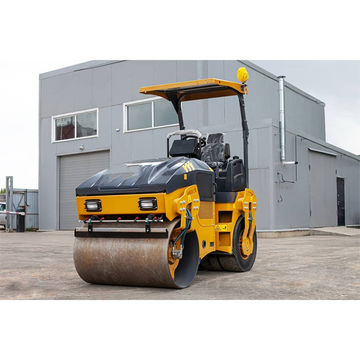Vibratory rollers are a crucial piece of machinery in the construction industry, specifically designed to compact various types of soil, asphalt, gravel, and other materials to create a stable foundation for roads, buildings, and other structures. These powerful machines utilize vibrations to efficiently and effectively compress the material, making them an indispensable tool in large-scale construction projects. Let’s delve deeper into what vibratory rollers are and how they work.
Understanding Vibratory Rollers:
Vibratory rollers, also known as vibro-rollers or vibratory compactors, come in different sizes and configurations, ranging from small handheld units to large heavy-duty machines. They typically consist of a large drum or drums, usually made of steel, which apply pressure and vibrations to the surface being compacted. These rollers are either self-propelled or towed behind a vehicle, depending on the size and application.
How Vibratory Rollers Work:
The working principle of a vibratory roller is relatively straightforward but highly effective. The key components involved in the operation of a vibratory roller include:
- Drum(s): The drum(s) of the vibratory roller are the primary contact point with the surface being compacted. These drums are equipped with protrusions or pads that create the necessary pressure points for effective compaction.
- Vibration Mechanism: Vibratory rollers are equipped with an eccentric shaft or mechanism located inside the drum(s). This mechanism generates powerful vibrations that are transmitted to the surface through the drum, causing the particles of the material to rearrange and settle more tightly together.
- Weight and Pressure: The weight of the vibratory roller, combined with the downward pressure exerted by the drum(s), plays a crucial role in compacting the material effectively. The heavier the roller and the higher the pressure applied, the better the compaction achieved.
- Frequency and Amplitude: The frequency and amplitude of the vibrations produced by the roller can be adjusted based on the type of material being compacted and the desired level of compaction. Higher frequencies and amplitudes are often used for denser materials, while lower settings may be suitable for softer or more delicate surfaces.
- Movement: In addition to the vibrations, vibratory rollers also move forward or backward to ensure uniform compaction across the entire surface. This movement helps in avoiding over-compaction or leaving behind uneven patches.
Applications of Vibratory Rollers:
Vibratory rollers find extensive use in a wide range of construction projects, including:
- Road Construction: Vibratory rollers are used to compact the subgrade, base, and asphalt layers during road construction, ensuring a smooth and durable surface.
- Landfills: They are employed to compact waste materials in landfills, reducing the volume of waste and preventing air gaps that can lead to environmental issues.
- Building Foundations: Vibratory rollers are used to compact soil and gravel during the preparation of building sites, providing a stable foundation for construction.
- Airport Runways: These rollers are essential for compacting the soil and asphalt layers on airport runways to withstand the heavy loads of aircraft.
Benefits of Vibratory Rollers:
- Efficient Compaction: Vibratory rollers offer rapid and efficient compaction, saving time and labor on construction sites.
- Improved Density: By using vibrations, these rollers can achieve higher levels of compaction and density compared to static rollers.
- Versatility: Vibratory rollers can be used on various types of materials, making them versatile for different construction projects.
- Cost-Effective: Their efficiency and effectiveness make vibratory rollers a cost-effective choice for construction companies, leading to savings in both time and resources.
In conclusion, vibratory rollers play a vital role in the construction industry by providing efficient and effective compaction of various materials. Their ability to generate powerful vibrations and apply uniform pressure makes them indispensable for creating stable and durable foundations in a wide range of construction projects.
